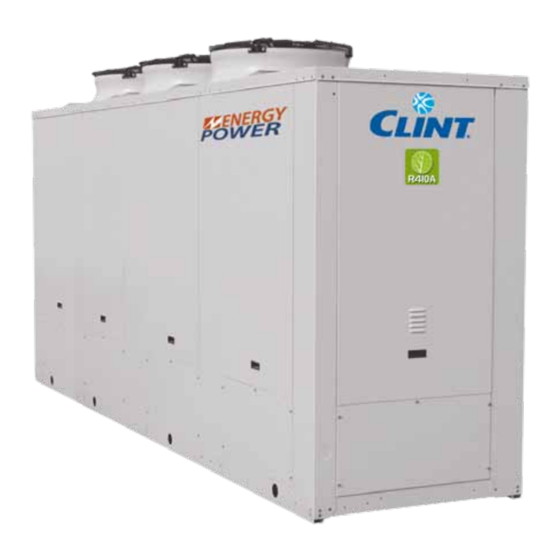
Summarization of Contents
1 INTRODUCTION
1.1 General information
General information about the CHA chillers, risks, and safe usage.
1.2 Attachments
Lists documents included as integral parts of the manual.
1.3 Warnings
Highlights safety and reliability design, compliance, and user responsibility for proper use.
2 UNIT DESCRIPTION
2.1 IDENTIFICATION
Explains how to identify the unit using labels on the frame and electrical box.
2.1.1 Unit identification
Details the specific information found on the unit's identification plates.
2.2 INTENDED USE
Describes the intended use of CHA chillers for cooling/heating water in closed circuits.
2.3 CONTRAINDICATIONS
Lists materials and conditions to avoid near the unit to prevent hazards.
2.4 GENERAL DESCRIPTION
Describes the unit's construction, panels, and overall design.
5 INSTALLATION
5.1 CHOOSING THE INSTALLATION SITE
Details factors for selecting the installation site, including weight, space, noise, and winds.
5.2 WATER CONNECTIONS
Provides instructions for connecting the chilled water circuit, including components and precautions.
5.2.1 General
General instructions and precautions for chilled water circuit installation.
5.2.2 Evaporator
Specific instructions for the evaporator water connection and flow requirements.
5.3 ELECTRICAL CONNECTIONS
Outlines procedures and precautions for electrical connections.
5.3.1 General
General instructions for electrical connections, emphasizing qualified personnel.
5.3.2 Electrical connections to the flow switch/water differential pressure switch
Details electrical connection for flow/pressure switches for water flow detection.
5.3.3 Electrical connections to the circulation pump
Explains how to electrically connect the circulation pump to the unit.
5.3.4 External signals
Describes how to connect external signals for remote ON-OFF control.
6 START UP
6.1 PRELIMINARY CONTROLS
Lists essential checks before starting the unit, covering electrical and hydraulic systems.
6.2 START UP
Guides on selecting operating modes and starting the unit, including compressor and fan behavior.
6.3 CHECKS DURING UNIT OPERATION
General checks for normal operation, including sounds, vibrations, and refrigerant circuit status.
6.3.2 Defrosting
Explains the automatic defrosting process for heat pump units.
6.4 STOPPING THE UNIT
Details the procedure for safely stopping the unit and warnings about power disconnection.
7 OPERATION
7.1 GENERAL
Instructions for starting and stopping the unit using the microprocessor and handling safety device resets.
7.2 SEASONAL SHUT DOWN
Procedures for seasonal shutdown, including draining fluids if temperatures drop below freezing.
8 TROUBLE SHOOTING
THE UNIT DOESN'T START
Lists common causes and recommended actions when the unit fails to start.
A COMPRESSOR DOESN'T START
Troubleshoots issues where a specific compressor fails to start.
THE COMPRESSOR STARTS AND STOPS REPEATEDLY
Addresses frequent starting and stopping of the compressor.
A COMPRESSOR DOESN'T START BECAUSE THE HIGH PRESSURE SWITCH HAS CUT IN (+)
Explains causes and solutions for high-pressure switch trips preventing compressor start.
A COMPRESSOR DOESN'T START BECAUSE THE LOW PRESSURE SWITCH HAS CUT IN (+)
Explains causes and solutions for low-pressure switch trips preventing compressor start.
THE FANS DON'T START
Troubleshoots issues where fans fail to start.
LACK OF REFRIGERANT LIQUID
Addresses problems related to insufficient refrigerant charge.
THE FLUID PIPE IS HOT
Discusses causes for the fluid pipe becoming hot.
THE FLUID PIPE IS COVERED WITH FROST
Explains reasons for frost formation on the fluid pipe.
THE UNIT CONTINUES TO WORK WITHOUT STOPPING
Troubleshoots units that run continuously without stopping.
THE UNIT WORKS REGULARLY BUT HAS AN INSUFFICIENT OUTPUT
Addresses issues where the unit operates but with reduced performance.
THE COMPRESSOR SUCTION LINE IS COVERED WITH FROST
Explains causes for frost on the compressor suction line.
THE DEFROSTING CYCLE IS NEVER ACTUATED
Troubleshoots failures in the defrosting cycle activation.
ABNORMAL NOISE IN THE SYSTEM
Identifies sources and solutions for unusual noises from the unit.
9 ROUTINE MAINTENANCE AND CONTROLS
WARNINGS
General warnings and precautions before performing maintenance or accessing internal parts.
9.1 GENERAL
Importance of periodic checks for correct unit operation and fluid draining for inactivity.
9.1.1 Monthly controls
Lists monthly maintenance tasks, including electrical checks, refrigerant inspection, and cleaning.
9.1.2 Four-monthly controls
Outlines quarterly maintenance tasks, focusing on fans, paint condition, and liquid indicators.
9.2 REPAIRING THE REFRIGERANT CIRCUIT
Emphasizes that refrigerant circuit repairs must be done by specialized personnel.
9.3 TOPPING UP THE REFRIGERANT
Details procedures for adding refrigerant, including limitations and when to fully recharge.
10 SHUT DOWN AND DISPOSAL
SHUT DOWN AND DISPOSAL
Instructions for decommissioning the unit at the end of its life and proper disposal procedures.
11 ADDITIONAL MULTIPURPOSE UNIT DESCRIPTION
11.1 FUNCTION DESCRIPTION
Explains the functionality of multipurpose units producing chilled and hot water on separate circuits.
11.2 REGULATION AND UNIT CONTROL
Describes how the unit is managed by two microprocessors for water temperature and system operations.
3 SAFETY
3.1 DEFINITION
Defines key terms like dangerous areas and exposed persons used in the safety chapter.
3.2 GENERAL SAFETY REGULATIONS
Lists essential safety rules and prohibitions for operating and maintaining the unit.
3.3 SYMBOLS
Explains the importance of regularly checking and maintaining safety plates.
3.3.1 Location of safety signs
Provides a diagram showing the location of various safety signs on the unit.
3.3.2 Safety signs
Details specific safety signs and their meanings, including distances and warnings.
3.4 EMERGENCY AND SAFETY DEVICES
Specifies the need for an external emergency circuit breaker for safety.
3.5 DESCRIPTION OF RESIDUE RISKS
Lists potential hazards near the unit, such as electrocution, cuts, and noise.
3.5.1 Residue risks near the unit
Lists potential hazards near the unit, such as electrocution, cuts, and noise.
3.5.2 Measures to take in case of leaking refrigerant gas
Provides first aid and environmental precautions for refrigerant leaks.
3.5.3 Operations with the panels removed
Outlines safety precautions when removing unit panels, including disconnecting power.
4 INSPECTION AND TRANSPORT
4.1 INSPECTION
Instructs on checking unit integrity upon receipt and reporting any transport damage.
4.2 STORAGE
Specifies the acceptable temperature range for storing the units.
4.3 LIFTING AND TRANSPORT
Details safe procedures for lifting and transporting the unit, emphasizing correct lifting points.
4.4 UNPACKING
Guides on unpacking the unit and proper disposal of packing materials.













Need help?
Do you have a question about the EP Series and is the answer not in the manual?
Questions and answers